Winter is here, whether we are ready for it or not. This time of year is hands-down not my favorite season. My idea of winter is keeping the thermostat set at 70ºF or more so my house is toasty warm.
Thankfully, all I have to do is seal the windows shut and turn the dial up on my thermostat. No worrying about moisture, wind, snow, sidewall curtains or fan speed. My furnace does the work for me at a mindless rate on my behalf. If only it was so easy on the farm, right?
Winter ventilation in the barn means keeping the air as dry as possible by the cows. The most important thing to do is keep the moisture out. When moisture enters the air in your barn, you are opening it up to fog, condensation, high humidity, frost on the building surfaces and, most importantly, respiratory problems in your cows.
When driving along country roads in wintertime, I often notice barns sealed up tight, done in hopes of picking up a few degrees inside the barn. Big mistake. You need airflow.
When you seal up the barn, you are creating unwanted moisture. You must know that cows can still produce very positive milk volumes in temperatures as low as -20ºF – as long as they are in a dry environment. Keeping the wind out of the barn is a key part of good milk volumes during the winter.
If the manure in the barn is not frozen when it is zero or below outside, or you see steam or haze in the barn, you are creating an environment for respiratory problems. If this is the situation in your barn, it is a good idea to reevaluate your current ventilation practices.
Naturally ventilated freestall barns
The purpose of a natural-ventilated freestall barn is to mimic the outside temperature, which during the winter season often means holding a temperature between 5ºF and 8ºF above the outside temperature.
The biggest mistake I see on dairies is closing the curtains up tight in hopes of keeping the cold air out. To keep air fresh in the barn, there needs to be a place for the fresh air to come in and a place for the warm, moist air (created by the animals) to escape.
The escape route is always going to be through the ridge, whether it be an open or overshoot ridge. In an open-ridge barn, the ridge is always kept open with no control of closing it. In an overshoot barn, if the curtain is closed tight, the air has nowhere to escape (Photo 1).
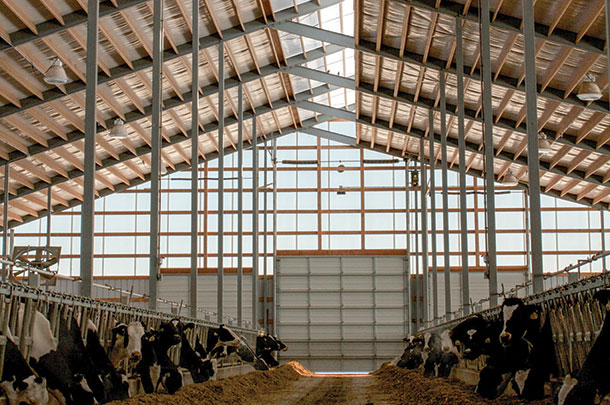 In a naturally ventilated barn, the ridge opening should be measured at a minimum of 2 inches per 10 feet of building width and the eave opening at least 1 inch per 10 feet of the building width, on both eaves.
In a naturally ventilated barn, the ridge opening should be measured at a minimum of 2 inches per 10 feet of building width and the eave opening at least 1 inch per 10 feet of the building width, on both eaves.
By following this guideline, the barn can take the greatest advantage of natural winds. When winds are strong and high, the curtain blocks them. But as soon as the wind drops back to a lighter force, re-adjust the curtains to the proper height for the best ventilation.
Cross-ventilated freestall barns
Unlike a naturally ventilated barn, in a cross-ventilated freestall, you rely on more than a curtain system to control the barn temperature. The primary focus is on the air exchange rate (Photo 2).
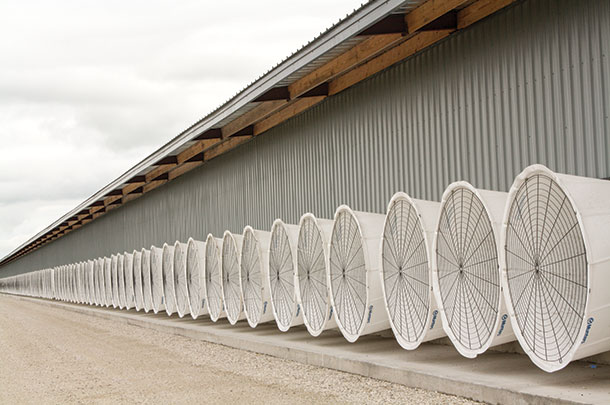 For a cross-ventilated barn in the winter, your goal is to slow the rate down three to four times that of the summer exchange rate, which means a target exchange rate between 180 and 240 seconds. If you can smell ammonia, the exchange rate is not adequate.
For a cross-ventilated barn in the winter, your goal is to slow the rate down three to four times that of the summer exchange rate, which means a target exchange rate between 180 and 240 seconds. If you can smell ammonia, the exchange rate is not adequate.
Further, if you notice steam in the barn, it is time to make adjustments to your exchange rate by turning on more fans and dropping the curtain open a bit more. It may take some time to figure out specifically what will work best for your particular situation.
Fans must run year-round in a cross-ventilated barn to make the system work. The fans are in control of pulling the fresh air across the width of the barn through the inlet on the opposite eave line.
In these barns, baffles are the key to directing fresh air onto the cows (Photo 3). Baffles should be located between 8 and 10 feet from the foot of the cows to keep the fresh air from rising. The baffle locations should be placed in the most effective areas to maximize the airflow at the point of cow contact with a maximum distance between each baffle of 60 feet.
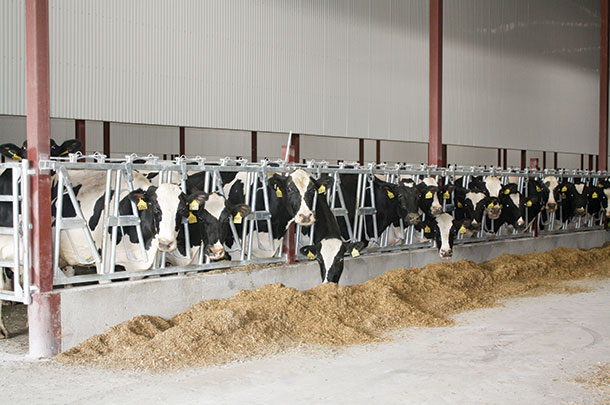 If a person elects to build a cross-ventilated freestall barn specifically with the mindset of working in a nice, warm barn and to eliminate freezing, you are building your barn for the wrong reasons. With this mindset, you are trading off the health of your animals for your convenience.
If a person elects to build a cross-ventilated freestall barn specifically with the mindset of working in a nice, warm barn and to eliminate freezing, you are building your barn for the wrong reasons. With this mindset, you are trading off the health of your animals for your convenience.
Tunnel-ventilated freestall barns
A lot of the same concepts from a cross-ventilated freestall barn apply to a tunnel-ventilated freestall barn. The difference between the two is the direction from which you are pulling the air.
In a tunnel-ventilated barn, the fans will always be on one endwall of the barn with inlets on the opposite endwall; the air travels the length of the barn, as opposed to the width with a cross-ventilation system.
In this style of barn, there is a designated set of fans that must run year-round. The remaining fans are turned on and off according to the outside temperatures. You must use your senses to fine-tune an automated system for the appropriate conditions.
Some farmers opt to incorporate natural ventilation concepts into a tunnel-ventilated freestall barn, which is often referred to as a “hybrid” barn. In this case, you should consider some of the above tips for naturally ventilated barns into your process to keep your winter air fresh and moisture-free.
It is extremely important to keep the moisture out and fresh air in the barns during winter because a damp, moist barn leads to respiratory issues with your cattle (Photos 4 and 5). Use your best judgment and trust your instincts.
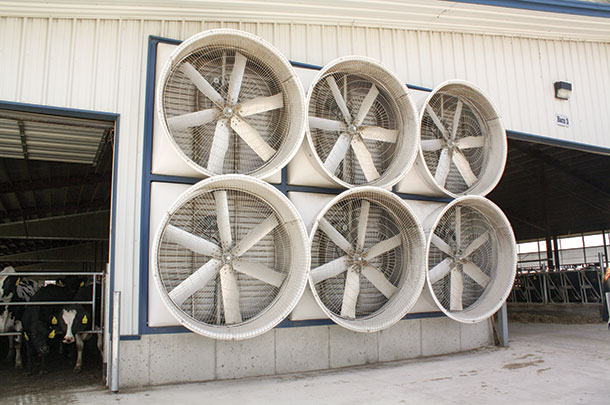
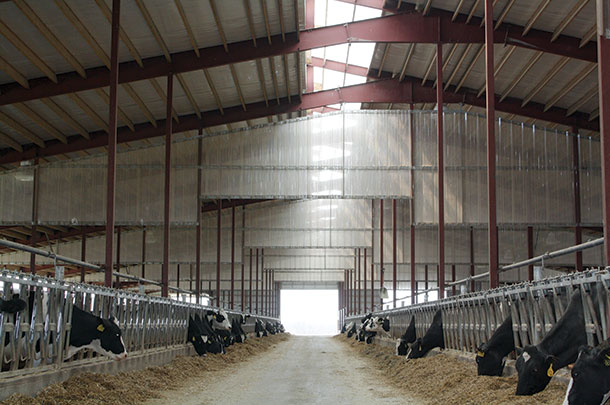 At the end of the day, when you go into the house and give your spouse that welcoming hug before dinner, if they tell you that you stink really bad, there is your red flag. Re-evaluate your ventilation practices by starting with the basics and make your adjustments accordingly. PD
At the end of the day, when you go into the house and give your spouse that welcoming hug before dinner, if they tell you that you stink really bad, there is your red flag. Re-evaluate your ventilation practices by starting with the basics and make your adjustments accordingly. PD
Ashley Ambrosius leads agriculture business development for Bayland Buildings, Inc. in Green Bay, Wisconsin.
Photo 1: An overshot ridge has an adjustable curtain at its opening to allow warm, moist air to escape.
Photo 2: In a cross-ventilated barn, fans draw air across the width of the building.
Photo 3: Baffles in a cross-ventilated barn maximize airflow at the point of cow contact.
Photo 4: A “hybrid” barn uses both natural ventilation as well as fans, which pull air the length of the barn.
Photo 5: When using a combination of natural and tunnel ventilation, baffles can help to direct airflow. Photos by Peggy Coffeen.






